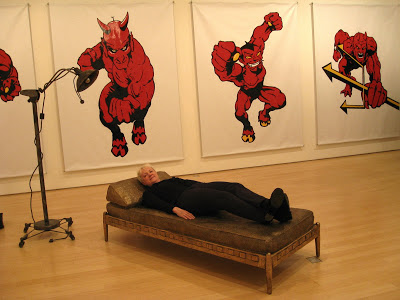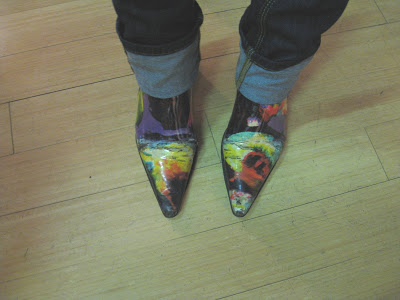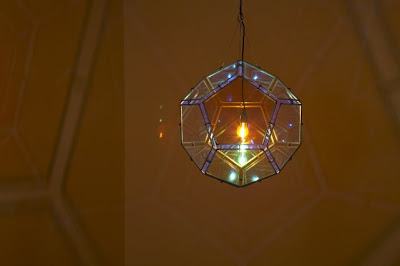2008
-

We can gloat, but things may not have changed so much in the last 50 years. It wasn’t reported that I know of, but in 2005 Christo startled the international press (and Mayor Bloomberg) assembled in the Metropolitan Museum’s Sackler Wing, by beginning his part of the press conference for The Gates with a fiery blast at The New York Times for not equally acknowledging Jeanne-Claude. Even after that, while most allusions are to “artists Christo and Jeanne-Claude,” there’s still the occasional Times article that refers to “The Gates” as “Christo’s project” or “dreamed up by Christo and his wife, Jeanne-Claude.” One veteran news reporter told me he didn’t ascribe it to sexism as much as a decision made by headline writers because Jeanne-Claude’s name is so long. Perhaps. But if they’d been writing about, say, Simon and Garfunkel would they leave off Garfunkel for brevity’s sake? Or refer to them as “Simon, and his partner, Garfunkel?” Don’t think so.

"Such tendencies can yield big advantages in the real world, where it's not always clear what information is important, or will become important."
This explains why, in seventh grade, I was never able to get over Mrs. Kluver’s coiled, movie queen hair and bulbous high-healed shoes to actually concentrate on what she was saying. Obviously I knew what was important even then.
 This is me, confronting my demons on the psychoanalytic couch that’s the centerpiece of Jude Tallichet’s show at Sara Meltzer. Cast in bronze and looking seductively comfy when it’s really hard—very hard—and scratchy, it’s the perfect metaphor. I’m not into back-stories, but that this is a replica of the couch from her late psychiatrist father-in-law’s office adds another poignant layer. I love Jude’s work because it’s conceptual yet meticulously rendered, as well as simultaneously deep and funny—like her. Also her friends have the best shoes. Here’s a little photo essay from Friday's opening:
This is me, confronting my demons on the psychoanalytic couch that’s the centerpiece of Jude Tallichet’s show at Sara Meltzer. Cast in bronze and looking seductively comfy when it’s really hard—very hard—and scratchy, it’s the perfect metaphor. I’m not into back-stories, but that this is a replica of the couch from her late psychiatrist father-in-law’s office adds another poignant layer. I love Jude’s work because it’s conceptual yet meticulously rendered, as well as simultaneously deep and funny—like her. Also her friends have the best shoes. Here’s a little photo essay from Friday's opening:






 Yesterday I went to see the Murakami show at the Brooklyn Museum with Judy Fox. On the ride back she told me about the time she spaced out on the subway and missed her stop. Finding herself at the end of the line, she jumped out, ran upstairs, over the bridge, and downstairs in time to catch the train as it came around to go uptown again, and when the doors opened she leapt in and sat down right next to…her purse.
Yesterday I went to see the Murakami show at the Brooklyn Museum with Judy Fox. On the ride back she told me about the time she spaced out on the subway and missed her stop. Finding herself at the end of the line, she jumped out, ran upstairs, over the bridge, and downstairs in time to catch the train as it came around to go uptown again, and when the doors opened she leapt in and sat down right next to…her purse.The last ten or more years have been tough on artists who take their work seriously. It's been challenging to persevere in a world that didn’t seem to value quality—to extend the analogy, like giving excellent love to someone who could care less. And in my other vocation, as an art writer, I’d go months without seeing anything that inspired me to put time and energy into writing about it. Now it’s hard to pick and choose and, in my enthusiasm, I may have taken on more than I can handle.
Also yesterday began and ended with a rethinking of artists I had previously written off (I love having my mind changed in a positive way; it's like yoga for the brain). The first was Rebecca Horn at Sean Kelly, whose glorious, light, oversize paintings on paper completely obliterated memories of the tower of rusted steel on the beach in Barcelona that prejudiced me. Also Walton Ford at Kasmin, whose new work has more weight and subtlety, with a new substance of concept that matches his technique. Then, as I was leaving Chelsea, I was drawn through Luhring Augustine’s open door by the energy of giant gestural grisaille abstractions by Christopher Wool, an artist whose work I’d previously only tolerated.
 REBECCA HORN
REBECCA HORNFlammen springen aus dem Herzen (Flames Burst out of the Heart), 2005
pencil, colored pen, acrylic, and Carmigniano on paper
paper: 71 5/8 x 59 1/8 inches (182 x 150 cm)
framed: 81 1/2 x 68 3/4 inches (207 x 174 cm)
©Rebecca Horn, Courtesy Sean Kelly Gallery, New York
Also this contemplative installation with water and reflection:
 REBECCA HORN Cinema vérité (The Snake's Ghost), 2008
REBECCA HORN Cinema vérité (The Snake's Ghost), 2008steel, copper, motor, water and projected lightdimensions variable
© Rebecca Horn, Courtesy Sean Kelly Gallery, New York
In between there were Rory Donaldson’s photographs at Winkleman, and Jeremy Gilbert-Rolfe’s beautiful paintings at Alexander Gray. I can show one here, but, like most everything, they don’t sing in reproduction as they do in person:
 JEREMY GILBERT-ROLFE, Thought in a Garden, oil on linen 86" x 38" x 1 1/4"
JEREMY GILBERT-ROLFE, Thought in a Garden, oil on linen 86" x 38" x 1 1/4"
And Ann Pibal's rigorous yet quirky paintings at Max Protetch: ANN PIBAL, Aerie, 2008, acrylic on aluminum, 44" x 66"
ANN PIBAL, Aerie, 2008, acrylic on aluminum, 44" x 66"
Word on the street after the opening of Geometry as Image at Robert Miller, was that it wasn’t a great show. That was also my take, but viewing it without a hundred million other people surging around me it was a pleasure, especially circumnavigating the Kenneth Snelson sculpture and seeing how it sets up Fred Sandback-like planes that are there and not there.
My hardy, gallery-going companion, Catherine Hamilton, and I struggled up in the elevator (friendly elevator guy, though, it helps) and down long hallways to the Bryce Wolkowitz Gallery for an excellent group show with a fascinating slow-time video piece by John Gerrard and yet another beautiful Olafur Eliasson lamp (I know Olafur works with a studio full of people—I’ve been there—but I’m beginning to think he had himself cloned a long time ago; he has another double museum show opening in and near Barcelona in June), and then to Tanya Bonakdar to have fun playing on a stringed instrument he had a hand in conceiving, on which you can make circular drawings to take home.

Dodcheron by Olafur Eliasson at Bryce Wolfowitz Gallery
I didn’t even finish seeing everything on my list. But there's still tomorrow and Friday, with friends' openings: Greg Drasler at Betty Cuningham, and Jude Tallichet at Sara Meltzer.
Off the Chelsea path, other work I liked a lot: Tomma Abts at the New Museum and Gert and Uwe Tobias at Team Gallery, 83 Grand in SoHo.
Update from Friday: The Milton Resnick show at Cheim & Read is spectacular. Before this, I only knew his more monochromatic work, but these earlier paintings represent the best of abstract expressionism. Also Thomas Zummer at Frederiecke Taylor.
I spent two full afternoons in Chelsea and still things slipped through the cracks that I now must go back to see, including Mark Di Suvero at Paula Cooper.
 David Humphrey, Sno Boy (2002), acrylic on canvas, 60 X 72 inches.
David Humphrey, Sno Boy (2002), acrylic on canvas, 60 X 72 inches. I’m not as interested in the Biennial as I am in the phenomenon of its dwindling cachet. On her blog, Joanne Mattera asks, “What if they gave a Biennial and nobody went?” That may already have happened.
Past Biennials, at least, generated controversy and discussion, which is always good for art, while the universal reaction to this one is shrugged shoulders.
Reasons given by the panel revolved around the Biennial’s abject subject matter and “bleak” atmosphere (“try bland,” the woman behind me muttered) and competition with art fairs. To my mind, however, it’s more about a segment of the art world that’s lost touch with its purpose and audience, and signifies a definitive break between idea-based art, as promoted by many art schools, and practice-based art—that which evolves from a more intuitive long-term exploration (where “work comes out of work” as Richard Serra has put it and I more recently heard Julie Mehretu say) as well as being grounded in visual experience.
When did we lose the “visual” in “visual art”? It's a long story, that goes back to suspicions about “beauty” that emerged during the 20th century, but I think there’s another component that comes out of my observations as a teacher--which is that many attending art school and going into the art professions today are not driven by an interest in things visual as much as they are in experiencing a creativity and autonomy (and lack of rigor, I might add snarkily) they don’t see offered by other professions. Add to this the “gathering tsunami of newly rich, clueless collectors infatuated with bright, neatly-made vision-free art” (as Michael Kimmelman put it in his review of the 2006 Biennial) and you get the current Biennial and art fair scene.
However I’m optimistic when I think about the enthusiastic responses Olafur Eliasson at MoMA and PS1 is generating, and how much intelligent, visually satisfying art I’ve seen this season in Chelsea galleries, of all places, by mid-career artists as well as new faces, much of it based on loose variations of pattern and geometric abstraction: Chris Martin, Juan Usle, Dan Walsh, Ann Pibal, Roberto Juarez, Thomas Nozkowski, Valerie Jaudon (this list is off the top of my head, so I may have left out some important examples).
To me, it’s symbolic of an important cultural shift, one that includes, yes, Obama. How do I make that leap? I keep going back to something my son, Matt, surmised and which I wrote about in January, that 2007 signified the cultural beginning of the new century, much in the way the Sixties, as we indentify it, really began in 1964. We’re over the negativity, fear mongering, hype, and anti-humanistic values of the last century. We want intelligence, substance, inspiration, and HOPE. We no longer want to be told what’s good for us, we know what’s good for us, and given a choice, we’ll choose that which uplifts us. Keep that thought.

Roberto Juarez, Whale (2008), at Charles Cowles Gallery through May 17th.